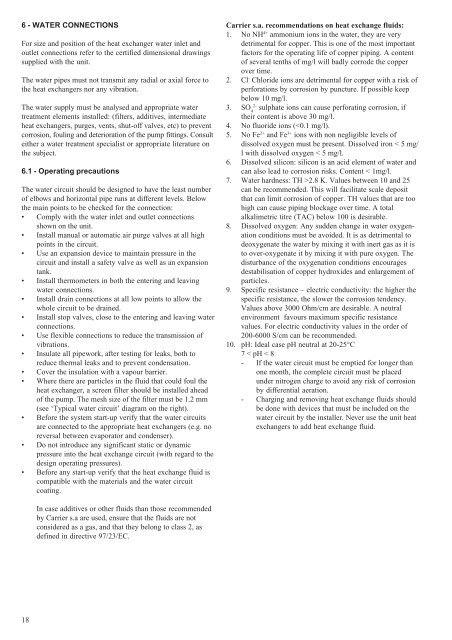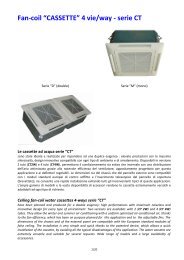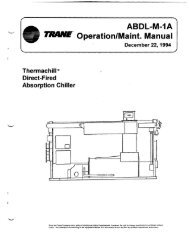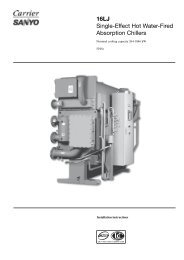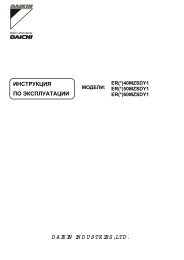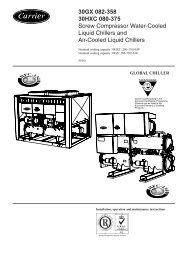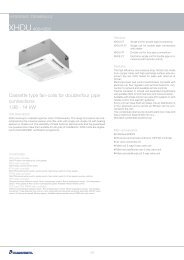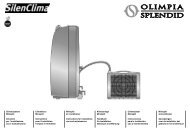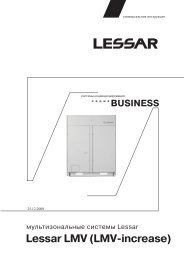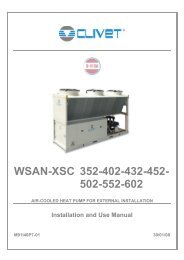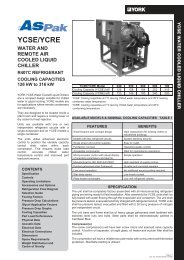30HZ/HZV 043-280 Water-Cooled/Condenserless Liquid Chillers
30HZ/HZV 043-280 Water-Cooled/Condenserless Liquid Chillers
30HZ/HZV 043-280 Water-Cooled/Condenserless Liquid Chillers
You also want an ePaper? Increase the reach of your titles
YUMPU automatically turns print PDFs into web optimized ePapers that Google loves.
6 - WATER CONNECTIONSFor size and position of the heat exchanger water inlet andoutlet connections refer to the certified dimensional drawingssupplied with the unit.The water pipes must not transmit any radial or axial force tothe heat exchangers nor any vibration.The water supply must be analysed and appropriate watertreatment elements installed: (filters, additives, intermediateheat exchangers, purges, vents, shut-off valves, etc) to preventcorrosion, fouling and deterioration of the pump fittings. Consulteither a water treatment specialist or appropriate literature onthe subject.6.1 - Operating precautionsThe water circuit should be designed to have the least numberof elbows and horizontal pipe runs at different levels. Belowthe main points to be checked for the connection:• Comply with the water inlet and outlet connectionsshown on the unit.• Install manual or automatic air purge valves at all highpoints in the circuit.• Use an expansion device to maintain pressure in thecircuit and install a safety valve as well as an expansiontank.• Install thermometers in both the entering and leavingwater connections.• Install drain connections at all low points to allow thewhole circuit to be drained.• Install stop valves, close to the entering and leaving waterconnections.• Use flexible connections to reduce the transmission ofvibrations.• Insulate all pipework, after testing for leaks, both toreduce thermal leaks and to prevent condensation.• Cover the insulation with a vapour barrier.• Where there are particles in the fluid that could foul theheat exchanger, a screen filter should be installed aheadof the pump. The mesh size of the filter must be 1.2 mm(see ‘Typical water circuit’ diagram on the right).• Before the system start-up verify that the water circuitsare connected to the appropriate heat exchangers (e.g. noreversal between evaporator and condenser).• Do not introduce any significant static or dynamicpressure into the heat exchange circuit (with regard to thedesign operating pressures).• Before any start-up verify that the heat exchange fluid iscompatible with the materials and the water circuitcoating.Carrier s.a. recommendations on heat exchange fluids:1. No NH 4+ ammonium ions in the water, they are verydetrimental for copper. This is one of the most importantfactors for the operating life of copper piping. A contentof several tenths of mg/l will badly corrode the copperover time.2. Cl - Chloride ions are detrimental for copper with a risk ofperforations by corrosion by puncture. If possible keepbelow 10 mg/l.3. SO 42-sulphate ions can cause perforating corrosion, iftheir content is above 30 mg/l.4. No fluoride ions (2.8 K. Values between 10 and 25can be recommended. This will facilitate scale depositthat can limit corrosion of copper. TH values that are toohigh can cause piping blockage over time. A totalalkalimetric titre (TAC) below 100 is desirable.8. Dissolved oxygen: Any sudden change in water oxygenationconditions must be avoided. It is as detrimental todeoxygenate the water by mixing it with inert gas as it isto over-oxygenate it by mixing it with pure oxygen. Thedisturbance of the oxygenation conditions encouragesdestabilisation of copper hydroxides and enlargement ofparticles.9. Specific resistance – electric conductivity: the higher thespecific resistance, the slower the corrosion tendency.Values above 3000 Ohm/cm are desirable. A neutralenvironment favours maximum specific resistancevalues. For electric conductivity values in the order of200-6000 S/cm can be recommended.10. pH: Ideal case pH neutral at 20-25°C7 < pH < 8- If the water circuit must be emptied for longer thanone month, the complete circuit must be placedunder nitrogen charge to avoid any risk of corrosionby differential aeration.- Charging and removing heat exchange fluids shouldbe done with devices that must be included on thewater circuit by the installer. Never use the unit heatexchangers to add heat exchange fluid.In case additives or other fluids than those recommendedby Carrier s.a are used, ensure that the fluids are notconsidered as a gas, and that they belong to class 2, asdefined in directive 97/23/EC.18


